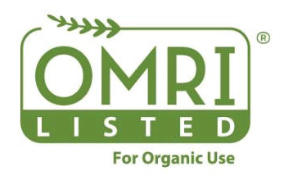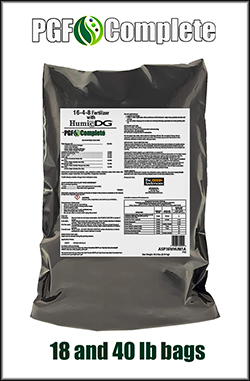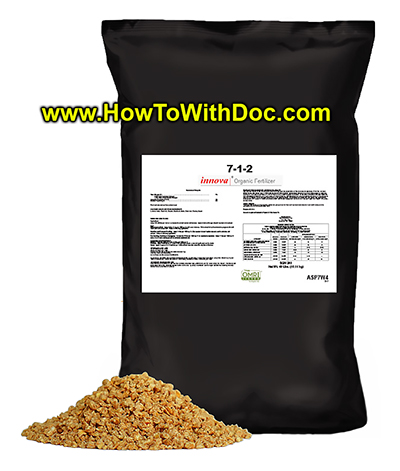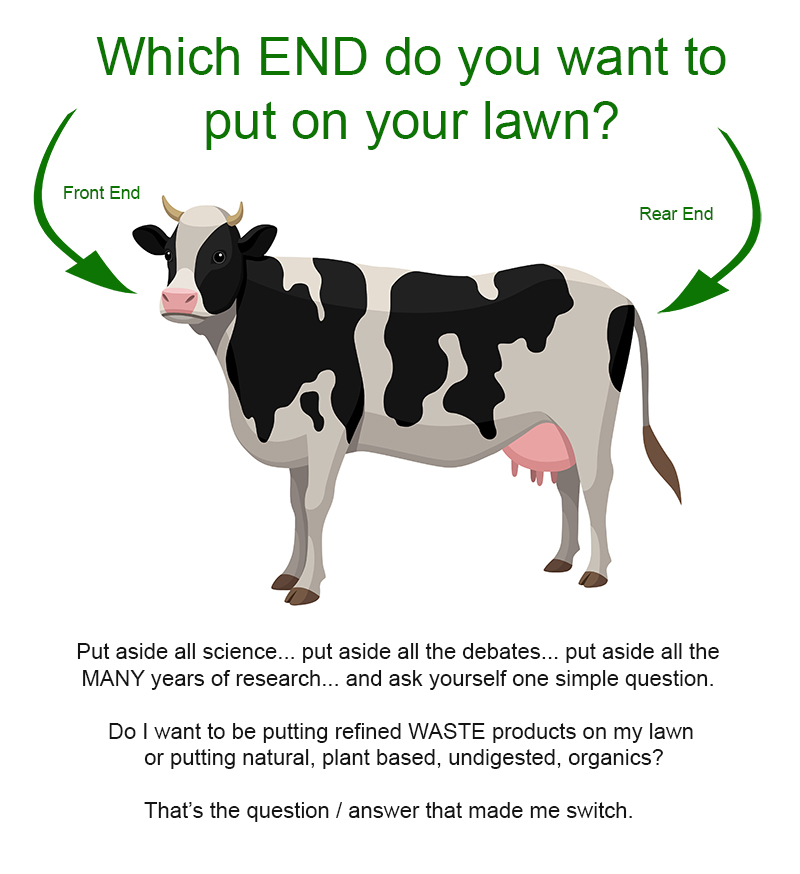Best organic lawn fertilizer for ALL LAWNS…
NOTE: Before using an ORGANIC fertilizer later in the year, you should FIRST USE PGF Complete.
Organic fertilizers do not perform well while temps are LOW so first put out PGF Complete.
Use on ANY lawn type… Bermuda Grass, Fescue, etc. One bag treats 11,000 sq ft at the “normal application rate” we have been using double that. Apply NOW… FALL… and then again in the spring when soil temps hit roughly 50 degrees or higher.
Click the picture for pricing and ordering.
Ask an expert to design a PERFECT lawn fertilizer… this is what you would get.
- 7-1- 2 Nitrogen – Phosphorus – Potassium Ratio (The perfect ratio)
- VERY HIGH in amino acids.
- High carbon to nitrogen ratio 6:1
- 100% Organic Listed and verified via OMRI
- No WASTE products – Animal Parts – manure – composted waste.
- 100% safe for pets and kids to walk and play on.
- WILL NOT burn your lawn… PERIOD.
- 100% Natural
- Great for ALL LAWNS… COOL AND WARM GRASSES.
See Pricing and Order Here
How to Apply?
- Cut grass BEFORE you apply. (I like to cut Bermuda a “TAD” lower than normal)
- Apply before a rain or water in afterward.
- If you have REALLY dense turf, use blower work any larger particles into grass.
- Put down as HEAVY as you want… don’t worry, it can’t burn.
- More is actually MORE… with this product, your lawn will love it.
- Spray lawn with super juice right after if you need instant color and growth.
- You’ll see a POP of color and growth in 7-14 days depending on climate and soil health.
- Use on any type lawn, cool or warm season turf.
- Apply NOW… in the fall and again in the spring when temps rise.
- You will see results in 7-14 days depending on the “environment”, conditions of your lawn, and weather.
Cost…
- As a say in the video… I’m NOT the budget guy. I find the BEST products that do what they say they will do and post my results. If you’re looking for the cheapest thing… mix beer and ammonia and spray on your lawn. (Good luck)
- Think in terms of 10,000s or 1/4 acres. An acre is just over 40,000 sq feet. So I think in terms of 10,000 units. (1/4 acres) My mind is a SIMPLE thing.
- One bag will cost you, with shipping… about $50 and it covers 1/4 acre at the standard rate. (We do apply heavier) Compared to other waste products that cost about $13 a bag ($15 a bag when you add in time and gas to pick up). They cover 2500 sq feet. So you would need 4 bags which is $60 . Even if you double the rate of the organic… and apply 3 times a year to 1/4 acre… You’re talking about $300 / year for the organic vs $180 for the waste. That’s $10 a month more. Choose wisely my friend….
Why Plant based vs. waste based?
Refined waste products are just that… refined animal or human waste products. There is no EXACT control as to what GOES IN… therefore there is no EXACT control as to what comes out. With plant based products, the process can be strictly controlled and what you are putting on your lawn is all natural and EATEN by living things… not gathered from the living thing’s waste. Once people read that statement, I think more than 50% will change their thought process. I did.
“I’ve been searching a LONG time for a certain lawn fertilizer.”
If you want to start a “DEBATE” ask things like… What’s the best motor oil? What’s the best drone? Which is the better truck? and of course… what is the best fertilizer? I’m NOT here to debate… only to share my experience and products that work in MY program for a great lawn.
Searching for the best fertilizer for Bermuda grass… I wanted a lawn fertilizer that was… 1- Organic… 2- Actually had N-P-K numbers matching a balanced nutrient formula (roughly 5-1-2) 3- Was slow release. 4- Had a good carbon to nitrogen ratio 5- Gave my lawn lots of amino acids. Not an easy task. Walk into any big box store and your choices are very limited. Most are in the 30-0-2 range and many contain weed controls. NOT what I want.
After months and months of searching I found a LARGE company with great quality control that had it. The problem… it was mostly available to lawn and turf professionals and not the consumer. After MANY communications… they agreed to list it for me, publicly, so you could buy it. AMEN… Our testing will be done over the next 2 years and we’ll constantly do updates.
See Pricing and Order Here
Understanding ORGANIC vs. SYNTHETIC fertilizers.
Synthetics… Chemicals and Minerals that directly feed the plant.
Generally speaking… synthetic fertilizers are mined chemicals, minerals, gases, and nutrients. You put these on your lawn / soil and the plants immediately uptake them while they are present. Pretty simple. You do run the risk of burning or over application based on your application rates and run off of these fertilizers can be an issue. If they say they are SLOW RELEASE… it’s because the manufacturer has delayed the release via some form of release constraints. Example: encapsulated in some form to release slowly each time the get wet. You are dependent on the WEATHER and rain for release amounts.
Organic fertilizers… Bio-matter that feeds the soil and is broken down slowly, thus feeding the plant.
Organic fertilizers are generally made from LIVING MATTER… plants, crops, waste, or animal by products. Your soil is a LIVING ecosystem full of microbial action. These organic fertilizers are “digested / processed” by your soil slowly and the nutrients they contain are now available to your grass LONG TERM. So the SLOW RELEASE action comes not from a manufacturing process, but rather the slow breakdown of the matter. Because of this there is generally zero chance of burn if the application rates are followed. Example: In times of drought, microbial action slows and the release of nutrients is slowed as well.
Why Plant based vs. waste based?
Refined waste products are just that… refined waste products. There is no EXACT control as to what GOES IN… therefore there is no EXACT control as to what comes out. With plant based products, the process can be strictly controlled and what you are putting on your lawn is all natural and EATEN by living things… not gathered from the living thing’s waste. once people read that statement, I think more than 50% will change their thought process. I did.
A good application program…
Best way to use them…
Because they are a slower feed process, we combine the application. If you have not put down a HUMIC product… this is a great time to get it down too. We like to put down the humic first, wet and allow it to enter the soil, then apply the following.
We put down the recommend rate (see below) and then immediately spray the lawn with an organic 10-1-2 liquid fertilizer. The SPRAY… will start to work very quickly feeding the lawn right away. The organic granular will take a little while to digest and release. However, once this is done, you are all set for the next 6-8 weeks.
Using this type of program we have COMPLETELY restored very weak lawns and greatly improved the thickness and color of our own. Make sure you follow our Bermuda grass calendars.
See Pricing and Order Here

More data on the fertilizer.
In addition to their role in cementing soil aggregates mentioned above, soil microbes are of paramount importance in cycling nutrients such as carbon (C), nitrogen (N), phosphorus (P), and sulfur (S). Not only do they control the forms of these elements [e.g. specialized soil bacteria convert ammonium N (NH4+) to nitrate N (NO3–)], they can regulate the quantities of N available to plants. This is especially critical in systems relying on organic fertilizers. It is only through the actions of soil microbes that the nutrients in organic fertilizers are liberated for plants and use by other microbes. Soil microbiologists call this process mineralization [the conversion of organic complexes of the elements to their inorganic forms, e.g., conversion of proteins to carbon dioxide (CO2) ammonium (NH4+) and sulfate (SO4=)]. It is perhaps the single-most important function of soil microbes as it recycles nutrients tied up in organic materials back into forms useable by plants and other microbes. In fact, the so-called Principle of Microbial Infallibility (popularized by Dr. Martin Alexander of Cornell University) states that for every naturally occurring organic compound there is a microbe or enzyme system that can degrade it. Note that this applies to naturally occurring compounds. It is obvious that some our persistent pesticides did not conform to this principle and even some naturally occurring compounds are fairly resistant to microbial attack. It is through the process of mineralization that crop residues, grass clippings, leaves, organic wastes, etc., are decomposed and converted to forms useable for plant growth as well as converted to stable soil organic matter called humus. Herein lies another important role for the larger soil animals like earthworms. The large organisms function as grinders in that they reduce the particle size of organic residues making them more accessible and decomposable by the soil microbes. The soil microbial population also further decomposes the waste products of the larger animals. Thus, the activities of different groups of soil organisms are linked in complex “food webs”.
One beneficial process carried out exclusively by soil microbes is called nitrogen fixation, the capture of inert N2 gas (dinitrogen) from the air for incorporation into the bodies of microbial cells. In one well-known form of this process, symbiotic nitrogen fixation, soil bacteria such as Rhizobium and Bradyrhizobium actually inhabit specialized structures on the roots of leguminous plants (soybeans, cowpeas, beans clovers, etc.) where they fix substantial quantities of nitrogen that becomes available to the host plant. Unfortunately, the root nodule system is not found in the grasses so we cannot rely on it for “free” nitrogen. Nevertheless, free-living (nonsymbiotic) nitrogen-fixing bacteria do associate with roots of grasses where they fix small quantities of nitrogen using carbon compounds (root exudates, sloughed root cells, etc.) produced from the roots as energy sources to drive the energy-expensive nitrogen-fixing enzyme system. Another factor limiting the utility of free-living N2 fixers is the fact that they will not fix N2 when exposed to even very low levels of fertilizer nitrogen. Thus in fertile turfgrass soils this process is of limited importance whereas in unfertilized prairie soils the 10 to 25 pounds of N fixed per acre per year is ecologically relevant.
Another benefit of soil microbes is their ability to degrade pest control chemicals and other hazardous materials reaching the soil. Thus through the actions of the soil microflora, pesticides may be degraded or rendered nontoxic lowering their potential to cause environmental problems such as ground and surface water contamination. Of course, there is a “downside” to this microbial capability. In some instances, soil microbes have been shown to degrade soil-applied pesticides so rapidly as to reduce the ability of the chemicals to control the target pests. This phenomenon is known as enhanced degradation and usually results from repeated applications of a chemical to the soil. One way around this problem is to vary the use of pest control chemicals.




